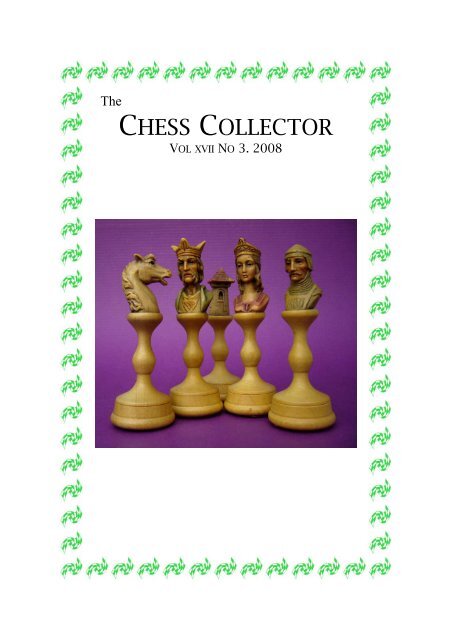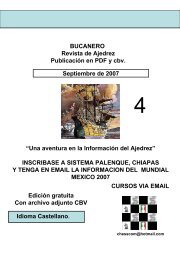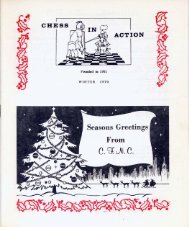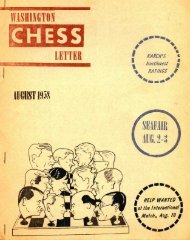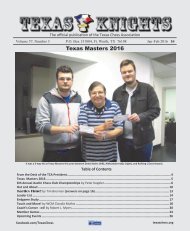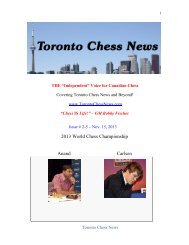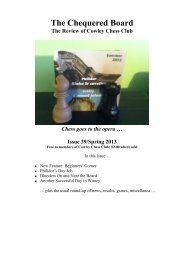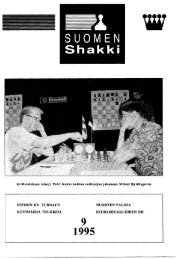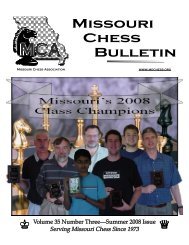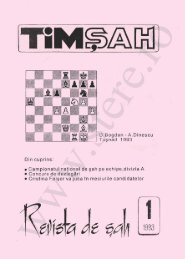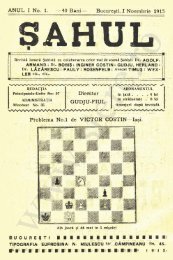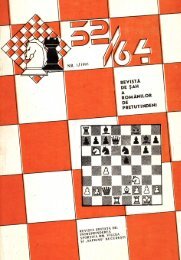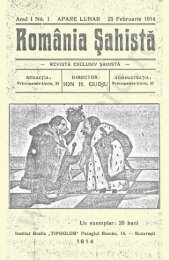The Chess Collector
El ajedrez es un juego, considerado un deporte, entre dos personas, cada una de las cuales dispone de 16 piezas móviles que se colocan sobre un tablero dividido en 64 escaques. En su versión de competición está considerado como un deporte.
El ajedrez es un juego, considerado un deporte, entre dos personas, cada una de las cuales dispone de 16 piezas móviles que se colocan sobre un tablero dividido en 64 escaques. En su versión de competición está considerado como un deporte.
You also want an ePaper? Increase the reach of your titles
YUMPU automatically turns print PDFs into web optimized ePapers that Google loves.
<strong>The</strong><br />
CHESS COLLECTOR<br />
VOL XVII NO 3. 2008
CONTENTS<br />
<strong>The</strong> <strong>Chess</strong> <strong>Collector</strong>. Vol XVII No3. 2008<br />
Editors / Members Comments Jim Joannou 2<br />
Your Move!. Members Page Alan Fersht 3<br />
Updates on Previous Issues Jim Joannou 4<br />
<strong>The</strong> Mao Tse Tung <strong>Chess</strong> set Rodolfo Pozzi 5<br />
BCC or not BCC. That is the question. Guy Loyns & others 6<br />
<strong>The</strong> artists who want a piece of the action <strong>The</strong> Telegraph online 10<br />
News in Brief 11<br />
<strong>Chess</strong> sets of the Philippines. Part 1. Jim Joannou 12<br />
A Cunning Move Novello Williams 17<br />
Auction Review Jim Joannou 17<br />
CCI Diary / CCI Information 19<br />
Advertisement 20<br />
Editor’s Comment<br />
<strong>The</strong> German CCI group held a regional<br />
meeting in Braunschweig recently, we<br />
hope to have a report and pictures in the<br />
next issue.<br />
During a recent work visit to Glasgow,<br />
Scotland, I was entertained by two fellow<br />
CCI members and I got the opportunity to<br />
view their collections. I would like to<br />
thank Peter Armit and Guy Lyons for a<br />
most enjoyable time.<br />
In this issue we have several articles of<br />
original research along with news and reviews.<br />
<strong>The</strong>re is also an update on items<br />
previously reported on.<br />
Do you know of a chess related website<br />
that could be reviewed in a future issue?<br />
<strong>The</strong>n send the web address to the editor.<br />
Members comments and views are always<br />
welcome, so keep them coming in and<br />
make this YOUR magazine!<br />
E-mail me at: jimjoannou@btconnect.com<br />
Jim Joannou.<br />
Editor<br />
~~~~~~~~~~~~~~~~~~~~~~~~~~~~~~~<br />
Front Cover<br />
Pieces from an Italian ANRI carved and<br />
polychromed wooden set. King 9.5cm.<br />
Sold on eBay recently for £650.<br />
Members Comments<br />
“With respect to Mr. Totaro's article (A<br />
Response to Mazzucco. VolXVII No 2.<br />
2008) I appreciated that he treated me with<br />
respect, despite my own readily acknowledged<br />
neophyte / novice approach, knowledge,<br />
and experience in that particular<br />
field. He seemed to be very professional<br />
and tactful as well as very informative. I<br />
liked the way he broke down his response<br />
in ways that were specific to particular aspects<br />
of my article. While he expresses<br />
opinion on many things, such as what is<br />
"desirable" to collect and what is not so<br />
desirable, he backs up his reasoning…<br />
Further on the most recent issue of CCI's<br />
<strong>The</strong> <strong>Chess</strong> <strong>Collector</strong>, despite past claims<br />
by at least one lost CCI member that the<br />
quality of CCI had gone down over the<br />
years, I appreciate the (even increasing)<br />
efforts and successes of the many contributions<br />
to this publication. <strong>The</strong> varied nature<br />
of the articles lend to an atmosphere<br />
of a well rounded group of collectors.<br />
John Mazzucco. USA<br />
“I very much enjoyed your article on travelling<br />
chess sets and the excellent magazine<br />
you produce”<br />
Chris Hall. UK<br />
2
<strong>The</strong> <strong>Chess</strong> <strong>Collector</strong>. Vol XVII No3. 2008<br />
YOUR MOVE !<br />
MEMBERS PAGE<br />
Harrwitz Find!<br />
Alan Fersht<br />
Just as I was leaving a second-hand bookshop<br />
cum bric-a-bric, I noticed some sets on the<br />
bottom shelf of a floor-standing, half hidden<br />
dusty cabinet. A new looking Staunton was at<br />
the front, surrounded by old cardboard boxes,<br />
labelled St. George. Ignoring the Staunton, I<br />
rummaged through box after box of “St. Georges”.<br />
<strong>The</strong>y were all cheap Regence sets, in the<br />
usual state of having replaced pieces, with<br />
none of them complete, and all at high prices.<br />
As an afterthought, I asked to see the Staunton.<br />
<strong>The</strong> pieces were all bright and shiny, the<br />
white a light boxwood yellow, the black looking<br />
glossy absolutely pristine. <strong>The</strong>y were unfelted<br />
and slight concave. But, they were all<br />
beautifully turned. <strong>The</strong>n came the knights:<br />
small and exquisite with drop jaws. This is<br />
now looking promising. <strong>The</strong> king, clearly 3.5”<br />
tall had a Jaques looking cross. Silly me, I<br />
hadn’t noticed the first time I picked it up that<br />
there was the tell-tale Jaques London around<br />
the rim. I told the dealer it looked to me to be<br />
about 1860, which surprised him, and paid up,<br />
content that I had secured a nice playing set at<br />
a good price.<br />
Driving back, my brain switched into the right<br />
gear as well. Unfelted? - I have never seen unfelted<br />
Jaques before. Those Bishops, that deep<br />
vertical slit in the only slightly bulbous mitre<br />
– isn’t that a hallmark of Frank Camaratta’s<br />
Harrwitz, the one on his website which shows<br />
the knights at a 45 degree angle where you<br />
cannot make out what the faces are really like?<br />
And, he wrote that they were unfelted and had<br />
the Jaques 1849-1852 green circle stuck on the<br />
wooden base. Fortunately, Dario Perez had<br />
sent me a fine photo of a Harrwitz set for my<br />
book, and I remembered that his 2 7/8” set had<br />
green stickers that had been stuck on the bare<br />
wood and clearly been felted over subsequently.<br />
<strong>The</strong> "Harrwitz" knights are the first of the<br />
"drop jaws", and have the upper teeth. <strong>The</strong><br />
black are made of boxwood.<br />
Home – straight to my book to check - yes,<br />
yes it is a very rare Harrwitz set, the only gap<br />
in my collection of early boxwood and ebony<br />
3.5” sets and the only type that I have never<br />
directly handled. My knights were indeed<br />
Harrwitz! So, I can now show photos of a near<br />
complete set of early knights and bishops<br />
http://www.fersht.com/chess/index.html<br />
<strong>The</strong>se sets are rare examples of being unfelted. Some still have their green registration stickers,<br />
indicating they are pre-1852.<br />
3
<strong>The</strong> <strong>Chess</strong> <strong>Collector</strong>. Vol XVII No3. 2008<br />
Updates on Previous Issues<br />
Jim Joannou<br />
Picasa websites<br />
In the last issue (VolXVII No 2. 2008), I<br />
informed members about a number of Picasa<br />
websites where a few members have<br />
put photo’s of their collections up for everyone<br />
to see.<br />
Here are some additional chess related Picasa<br />
sites:<br />
“<strong>The</strong> most expensive chess set ever made”,<br />
but at the time only the King had been produced.<br />
<strong>The</strong> set, completed in 2006, is valued<br />
at over 5 million Pounds but a limited number<br />
of replicas will be priced at £20,000.<br />
Constructed in gold and platinum, it is set<br />
with diamonds, emeralds, rubies, sapphires<br />
and pearls.<br />
http://picasaweb.google.co.uk/alfaman101<br />
(<strong>The</strong> collection of USA collector Dennis<br />
Hunt)<br />
http://picasaweb.google.co.uk/<br />
thechesscollectors<br />
(A site with a large number of pictures of<br />
chess sets by collector Robert Van De Veur<br />
from <strong>The</strong> Netherlands)<br />
http://picasaweb.google.co.uk/mickdeasey<br />
(<strong>The</strong> collection of UK collector Mick<br />
Deasey)<br />
http://picasaweb.google.co.uk/baron.von.<br />
drivel<br />
(A relatively new collector, Duncan Pohl<br />
from the USA)<br />
~~~~~~~~~~~~~~~~~~~~~~~~~~~~~~~~<br />
<strong>The</strong> Jewel Royale <strong>Chess</strong> set<br />
In Vol XIV No 2 Winter 2005, we reported<br />
on a one-off chess set being made by noted<br />
London jewelers, Boodles. It was billed as<br />
Close-up of the Knights<br />
<strong>The</strong> set’s playing surface is made of yellow<br />
and white gold and set with diamonds.<br />
Award winning writer Clifford Thurlow has<br />
been commissioned to write a thriller entitled<br />
“Checkmate”, with the central plot<br />
based around the Jewel Royale chess set.<br />
Detail of the<br />
Bishops<br />
mitre<br />
<strong>The</strong> Completed set worth over £5 million<br />
4
<strong>The</strong> <strong>Chess</strong> <strong>Collector</strong>. Vol XVII No3. 2008<br />
<strong>The</strong> Mao Tse Tung <strong>Chess</strong> set<br />
Rodolfo Pozzi<br />
It is a well known fact that Mao Tse Tung<br />
prohibited chess in China, as would the<br />
Taliban years later in Afghanistan. We also<br />
know that later, when the game was liberalized,<br />
the Chinese were finally able to express<br />
their mastery of the game by ranking<br />
several of their male and female champions<br />
among the best in the world.<br />
Mao (1893-1976) hosted many personalities,<br />
particularly from Russia, who wanted<br />
to play chess, so he had appropriate chess<br />
sets made to be played on a wooden chessboard.<br />
<strong>The</strong> pieces were made of coneshaped<br />
bamboo bodies, with the western<br />
reminiscent of the Great Wall of China.<br />
<strong>The</strong>se sets, which may be dated back to the<br />
mid-twentieth century, do not boast a particular<br />
aesthetic or high commercial value,<br />
but because they were conceivably produced<br />
in a limited edition, they undoubtedly<br />
serve as an interesting historical document.<br />
Editors Note: A similar set with triangular<br />
bodies in place of the cone shaped bodies<br />
was also produced.<br />
symbols at the top and light wood bases<br />
painted in white or black. To make them unmistakably<br />
Chinese, the torsos of figures<br />
enclosed in oval shapes were etched onto<br />
the bamboo and colored (the same figures in<br />
red and black, on the front and on the back).<br />
For example the King, 11.2 cm high, is a<br />
dignitary with a beard and a mustache and a<br />
Chinese hat, the queen is crowned and bejeweled,<br />
slightly taller than the King, the<br />
Pawns are young men and the Rook is<br />
5
<strong>The</strong> <strong>Chess</strong> <strong>Collector</strong>. Vol XVII No3. 2008<br />
BCC or not BCC. That is the question.<br />
Researched by Guy Lyons with help from Frank Camarrata<br />
and Mick Deasey. Edited by Jim Joannou.<br />
How often have <strong>Collector</strong>s seen Staunton<br />
type sets, described as BCC (British <strong>Chess</strong><br />
Company) on eBay? Maybe even purchased<br />
a set or two attributed to the BCC, but found<br />
little direct evidence? Maybe even asked a<br />
seller direct questions about the origin and<br />
got no satisfactory answer?<br />
On searching through the CCI publications I<br />
found not one single article had been written<br />
on British <strong>Chess</strong> Company sets! All rather<br />
interesting! So I decided to put together a<br />
folder of images, of every set I could find<br />
and investigate. Thanks to Robert Stoller, I<br />
found out that the Cleveland Library had a<br />
copy of the 1891 BCC catalogue and on contacting<br />
them they very kindly mailed me a<br />
copy. (Fig 3) All this was over two years ago.<br />
Fig 1, an advert from an 1890’s British<br />
<strong>Chess</strong> Magazine (BCM), shows my preferred<br />
BCC set, <strong>The</strong> Royal <strong>Chess</strong>men. But<br />
there have been suggestions that this was a<br />
copy of a Jaques set! However every piece<br />
in this pattern has a differing style to a<br />
Jaques. <strong>The</strong> Royal set was produced in<br />
wood in several sizes including the large<br />
club size. <strong>The</strong>y were also made in ivory but<br />
these are extremely rare. Fig 2, a BCM advert<br />
also from the 1890’s, shows <strong>The</strong> Staunton<br />
<strong>Chess</strong>men, which are closer to a Jaques<br />
pattern except for the knights. This set was<br />
also offered with a Kings knop rather than a<br />
cross, which may have been due to breakages.<br />
It is worth noting here that the British<br />
<strong>Chess</strong> Company was catering for the <strong>Chess</strong><br />
Clubs rather than the retail market.<br />
Fig 1. Advertisement from the British <strong>Chess</strong><br />
Magazine dated 1890.<br />
Fig 2. Advertisement from the British <strong>Chess</strong><br />
Magazine dated 1890.<br />
6
<strong>The</strong> <strong>Chess</strong> <strong>Collector</strong>. Vol XVII No3. 2008<br />
BCC or Not BCC. That is the Question.<br />
What was mighty puzzling was that the patterns<br />
bore little resemblance to many sets<br />
that were described as BCC. So I contacted<br />
Frank Camarrata, who has a fine collection<br />
of BCC sets. Frank was very helpful and<br />
spent considerable time mailing information<br />
to me. However I still could not grasp<br />
the obvious; <strong>The</strong> BCC Staunton, (Fig 2)<br />
was in fact the Imperial design or improved<br />
Staunton. (Fig 3. Right hand page) So any<br />
set “not” similar to this design but described<br />
as BCC, needed questioning. Frank<br />
simply told me I was probably looking for<br />
the Holy Grail, or the Ark of the Covenant,<br />
“Stick to the Knights, and the catalogue<br />
patterns illustrated” he told me. It was incredible<br />
but it took me two years to understand<br />
what he meant. I kept looking at sets<br />
described as BCC, which now appear to be<br />
incorrect. I then received help from a few<br />
other collectors, one in particular, Mick<br />
Deasey, needs a special mention. He spent<br />
considerable time researching the founders<br />
of the Company, and its probable life span.<br />
Between us we checked various 1890s publications<br />
including the British <strong>Chess</strong> Magazine,<br />
<strong>The</strong> Times Archives, etc. and then,<br />
upon the advice of Michael Mark, <strong>The</strong><br />
<strong>Chess</strong> Amateur. Mike Darlows book “A<br />
study of Turned <strong>Chess</strong>men” also helped.<br />
Continued<br />
<strong>The</strong> results of this research made for some<br />
interesting speculation.<br />
It appears that the British <strong>Chess</strong> Company<br />
may have had a rather short life span,<br />
~1888 -1905, but were only a serious maker<br />
for possibly 6 years. This at least makes<br />
some sense, as their factory at Rock Mill<br />
Stroud, was demolished in 1897. Also, as<br />
an exercise, I did a quick analysis of the<br />
numbers of known BCC sets (2004-2007 in<br />
auction catalogues) compared to Jaques sets<br />
and it came out as roughly 40/1. Now that<br />
is a huge difference. <strong>The</strong> competition in the<br />
1890s was pretty fierce, as Jaques, and<br />
Ayers were very active, plus other copy<br />
makers of Staunton type sets, were about.<br />
Finally the <strong>Chess</strong> Amateur publication<br />
based in Stroud, UK from 1907 had a W<br />
Moffat on its staff and he was also<br />
a founding partner in the British <strong>Chess</strong><br />
Company! It is strange that not a single advertisement<br />
for any BCC set can be found<br />
in this publication despite that fact that<br />
BCC sets were on offer from the <strong>Chess</strong><br />
Amateur depot in Stroud after the demise of<br />
the BCC! <strong>The</strong>re was no mention of the<br />
BCC name, so one can infer that by this<br />
time (1907) they were selling surplus stock<br />
from the 1890’s.<br />
Fig 3. Photocopies of the BCC catalogue of 1891. Supplied by the Cleveland library.<br />
7
<strong>The</strong> <strong>Chess</strong> <strong>Collector</strong>. Vol XVII No3. 2008<br />
BCC or Not BCC. That is the Question.<br />
Continued<br />
Now when one studies the two wellknown<br />
designs of BCC, the Royal and the<br />
Imperial, it is mainly the Xylonite knights,<br />
(See 1891 catalogue in Fig 3) plus their<br />
labeled boxes, that offer clues to the<br />
maker. Xylonite was an early plastic, and<br />
the company was so keen on this new material,<br />
they even, made some complete sets<br />
of Xylonite and even a chessboard. <strong>The</strong><br />
evidence suggests that it was not accepted<br />
by the club players of the time and none<br />
too many of these sets appear to have survived.<br />
Fig 4 shows the BCC Imperial chessmen,<br />
which was a new pattern introduced in<br />
1900. It was unique in that the height of<br />
the pieces reflected their relative strength.<br />
Hence the Rooks are taller than the Bishops<br />
and Knights. <strong>The</strong>re is some evidence<br />
that this set was produced with a<br />
“notched” Maltese style Kings cross instead<br />
of a round finial and also with two<br />
versions of the knight.<br />
<strong>The</strong> BCC produced two basic designs, <strong>The</strong><br />
Imperial and <strong>The</strong> Royal but there were<br />
also variations on these two styles, e.g.<br />
<strong>The</strong> Staunton <strong>Chess</strong>men set. (Fig2) Both<br />
of the two main designs featured the<br />
unique Xylonite heads on the knights, although<br />
the knights could be “upgraded” to<br />
hand carved boxwood and ebony, which<br />
according to Frank Camarrata, are magnificently<br />
carved. Fig 4 shows an Imperial<br />
BCC set which was itself a variation of the<br />
Staunton design (Also referred to as Improved<br />
Staunton) and replaced an earlier<br />
Imperial style, which did not have Xylonite<br />
knights.<br />
Other identifying features include large<br />
base diameters on all BCC sets, Rooks<br />
with four castellations, which on the Royal<br />
sets were slightly angled inwards and doubled<br />
large collars on the Imperial<br />
(Improved Staunton) designs.<br />
Like Jaques sets, all BCC sets came with<br />
the red crown mark on the summit of the<br />
Kings rooks but the knights were marked<br />
on the sides of their bases.<br />
Fig 4. A BCC Imperial set (Improved<br />
Staunton) with the Xylonite Knights heads<br />
<strong>The</strong> boxes that BCC sets came in are also<br />
important for identification. (Fig 5) Many<br />
of their boxes had “<strong>The</strong> British <strong>Chess</strong><br />
Company, Stroud” impressed along the<br />
edge of the lower half of the box next to<br />
Fig 5. Two BCC sets in their boxes. Note<br />
the rounded corners and White labels.<br />
Fig 6. A collectable set described as BCC<br />
but close inspection confirmed that it<br />
couldn’t be BCC.<br />
8
<strong>The</strong> <strong>Chess</strong> <strong>Collector</strong>. Vol XVII No3. 2008<br />
BCC or Not BCC. That is the Question.<br />
Continued<br />
the top plate of the lock. Some boxes came<br />
with rounded corners, a semi-mortice lock,<br />
were lined inside and also came with a<br />
white label although some pale green labels<br />
have also been seen. An upgrade to a<br />
polished rosewood box was also offered.<br />
<strong>The</strong>y also produced a square cornered box<br />
with thinner walls and an “hook & eye”<br />
fastener for the lid. <strong>The</strong>se were not lined<br />
but still came with the white label. After<br />
the demise of the BCC in approx 1907, it<br />
is strongly suspected that their old stock<br />
was sold off (as already mentioned above)<br />
by the <strong>Chess</strong> Amateur depot, and the<br />
boxes probably had their labels removed.<br />
Fig 6 shows a collectable set, which was<br />
described by a dealer as BCC. However on<br />
examination one notes that the rooks have<br />
five castellations instead of four, detailed<br />
study of the “turning signature” has little<br />
resemblance to other BCC sets and the<br />
knights, carved in wood, are nothing like<br />
the styles noted in the BCC catalogues.<br />
(See fig 1,2 & 3) and finally the knights<br />
have the red crown stamped on the top and<br />
not on the bases. <strong>The</strong>refore, although still<br />
a fine set, it cannot be of British <strong>Chess</strong><br />
company origin.<br />
I cannot be 100% sure BCC did not make<br />
any copy Jaques look-alike sets in the<br />
1890s, but if they did, it does seem odd<br />
that no adverts for these can be found in<br />
the <strong>Chess</strong> Amateur, and why would they<br />
have changed their unique design! Again,<br />
if they did make copy sets, and there is no<br />
shortage of unknown Staunton pattern sets<br />
about on eBay each week, why do they appear<br />
to have disappeared by 1905? Every<br />
Illustration I have seen in old publications,<br />
show either the Royal or Imperial design<br />
and unlike some makers, including Jaques,<br />
they were pretty accurate too.<br />
I purchased three sets attributed to BCC in<br />
2005, and now I am pretty convinced these<br />
sets were not made by that company, however<br />
they are still collectable sets, either<br />
Antique or early Vintage, and I suspect the<br />
sellers, simply did not do the in-depth research,<br />
that both myself, and fellow collectors<br />
have now managed to complete.<br />
Today the Internet offers us collectors a<br />
tremendous opportunity to source information<br />
that simply was nothing like as easy<br />
to obtain previously.<br />
To summarise, here is a list of clues that<br />
will help identify a BCC set:<br />
1) Kings have a rounded Knop or a<br />
notched Maltese style Cross<br />
2) Wide Bases on all pieces<br />
3) Xylonite Knights’ heads or similar<br />
styles in Boxwood and Ebony<br />
4) Rooks have four Castellations<br />
5) Red Crown Stamped on the<br />
Knights’ bases<br />
6) <strong>The</strong> boxes are stamped and have<br />
white labels and the best boxes<br />
have rounded corners<br />
I hope BCC collectors in the CCI will appreciate<br />
that this article is not designed to<br />
“have a go” at <strong>Chess</strong> Dealers or sellers. It<br />
is simply the work of a collector, who<br />
wished to research a known company,<br />
with welcome and much appreciated help<br />
from other CCI members. I cannot claim<br />
to have established absolute proof that I<br />
am correct in my article, but then again I<br />
have seen little, if any, evidence that many<br />
chess sets attributed to BCC are in fact<br />
correct. I do hope my good friend Mick<br />
Deasey, does a more detailed article on<br />
British <strong>Chess</strong> Company for the CCI in a<br />
future issue, as it sure would be a welcome<br />
addition for BCC collectors like myself.<br />
9
<strong>The</strong> <strong>Chess</strong> <strong>Collector</strong>. Vol XVII No3. 2008<br />
<strong>Chess</strong>: <strong>The</strong> artists who want a piece of the action<br />
(Extracts from Telegraph online 13th Aug 2008)<br />
A recently formed art company called RS&A<br />
commissioned five prominent artists, including<br />
Damien Hirst and the Chapman brothers,<br />
to create bespoke sets that have been exhibited<br />
all over the world.<br />
Japanese-born Yayoi Kusama adapted an<br />
18th-century design with her trademark<br />
painted polka dots. <strong>The</strong> mischievous Italian<br />
artist Maurizio Cattelan, best known for his<br />
1999 waxwork mannequin of the Pope being<br />
squashed by a meteorite, replaced traditional<br />
chess figures with delicate porcelain figurines<br />
depicting recognisable people and characters<br />
associated in his mind with good and<br />
evil.<br />
<strong>The</strong> RS&A chess sets were inspired by a<br />
similar project that happened nearly six decades<br />
earlier. In 1944, the artist, photographer<br />
and chess obsessive Man Ray staged an exhibition<br />
called <strong>The</strong> Imagery of <strong>Chess</strong> at Julien<br />
Levy's gallery in New York, featuring sets<br />
and boards by a number of celebrated Modernist<br />
artists including Alexander Calder and<br />
Max Ernst.<br />
But why have so many artists wanted to design<br />
chess sets? "<strong>Chess</strong> is often used as a<br />
metaphor for all kinds of things, such as politics,<br />
war and even family strife," says Malcolm<br />
Pein, chess correspondent of <strong>The</strong> Daily<br />
Telegraph. "And that appeals to artists."<br />
That's certainly the case with Damien Hirst.<br />
His 2003 set, Mental Escapology, consists of<br />
ranks of medicine bottles cast in silver and<br />
glass, with modified labels sandblasted and<br />
etched on each side. "Damien sees a link between<br />
powerful medical companies and<br />
power play in chess," says Julia Royse of<br />
RS&A.<br />
Over the past five years, Royse has commissioned<br />
seven more artists to produce chess<br />
sets, which are sold in editions of seven for<br />
between £25,000 and £150,000 each. <strong>The</strong><br />
sets bear the distinctive stylistic fingerprints<br />
of the artists who made them, demonstrating<br />
that, in the right hands, chessmen can<br />
be tiny sculptures. Five of the sets have<br />
already been exhibited in Moscow and<br />
New York, but two more are about to be<br />
unveiled.<br />
Tracey Emin is working on a travelling<br />
chess set, with bronze pieces and a multicoloured<br />
board of quilted fabric that can<br />
be rolled up and placed inside an embroidered<br />
cloth bag. “<strong>The</strong> last time I played<br />
was in Africa in the middle of nowhere, so<br />
I like the idea of producing a travelling<br />
chess set." says Emin.<br />
Gavin Turk, another artist closely associated<br />
with the YBAs, is responding tangentially<br />
to RS&A's commission, by producing<br />
a 20-minute film instead of a chess set<br />
that was screened in Dublin as part of the<br />
Art of <strong>Chess</strong> exhibition at the Sebastian<br />
Guinness Gallery. In the film, the artist<br />
dresses up as the famous "Mechanical<br />
Turk", a chess-playing automaton constructed<br />
in 1770 by the Austrian nobleman<br />
Wolfgang von Kempelen.<br />
Further info:<br />
www.r-s-a.co.uk<br />
www.sebastianguinnessgallery.com/site/<br />
home.php?ID=1<br />
Gavin Turk as “<strong>The</strong> Turk” in his 2008<br />
film.<br />
10
<strong>The</strong> <strong>Chess</strong> <strong>Collector</strong>. Vol XVII No3. 2008<br />
NEWS IN BRIEF<br />
New Gold and Diamond chess set<br />
unveiled<br />
New in designer Charles Hollander’s collection<br />
is a chess set made out of gold<br />
with the king and queen set with diamonds.<br />
This time the king and queen actually<br />
feature fake figurines to make the<br />
set more interesting. (No word on price<br />
as yet but I bet I will not be able to afford<br />
one! - Editor)<br />
Two listings of Red and Butterscotch Bakelite<br />
<strong>Chess</strong> sets were up for sale recently<br />
one sold for $380 and the other for $285.<br />
A good German woodset (King 8.5cm)<br />
sold for £102, including a board, and an<br />
old Austrian wooden set from the same<br />
seller went for £103. Fig 2 shows a rare<br />
ivory set in a quality wooden casket which<br />
sold for £480.<br />
~~~~~~~~~~~~~~~~~~~~~~~~~~~~~~~<br />
<strong>Chess</strong> sets on eBay<br />
Listed as a “vintage travelling set” (Fig<br />
1) this small folding board with Staunton<br />
style pieces in good condition sold for<br />
just £77. A similar set sold at Christie’s<br />
in 2006 for £200!<br />
Fig 2<br />
~~~~~~~~~~~~~~~~~~~~~~~~~~~~~~~<br />
Earth vs Space <strong>Chess</strong> match!<br />
An astronaut aboard the International<br />
Space Station began the chess match on<br />
Sept. 29, playing against the public on<br />
Earth. <strong>The</strong> play being led by Schools and<br />
Clubs in the USA suggest 4 moves and<br />
then the public vote on which move goes<br />
out into space. Anyone can vote via the<br />
Web site: www.uschess.org/nasa2008.<br />
Fig 1<br />
11<br />
<strong>The</strong> online voting is being hosted by the<br />
U.S. <strong>Chess</strong> Federation (UCSF).
<strong>The</strong> <strong>Chess</strong> <strong>Collector</strong>. Vol XVII No3. 2008<br />
Introduction<br />
CHESS SETS OF THE PHILIPPINES.<br />
Part 1.<br />
Modern Playing Sets & <strong>The</strong> Moro Mystery Revealed.<br />
Jim Joannou<br />
<strong>The</strong> Philippines has a long history with<br />
<strong>Chess</strong> 1, 2 . <strong>The</strong>re are many organised competitions<br />
and some strong international players<br />
have, and still are, emerging from this interesting<br />
and diverse country. We will look at<br />
the different chess designs that have developed<br />
and emerged from this far eastern<br />
country in two parts and discover what they<br />
represent or how they developed. <strong>The</strong> one<br />
golden rule that will emerge from these articles,<br />
when studying sets from the Philippines<br />
is: When in doubt, study the culture of<br />
the people!<br />
<strong>The</strong> Philippines are a group of approx 7100<br />
islands off the south coast of China and is<br />
classed as sub-tropical. <strong>The</strong> nature of the<br />
country (Mountainous regions, remote islands<br />
and high poverty levels) has resulted<br />
in some diverse and mixed cultures. For example,<br />
the major religion is Catholicism but<br />
there is a high Muslim population in the far<br />
south of the country. Despite the Filipino’s<br />
being quite religious there also exists a degree<br />
of symbolism and pagan style imagery.<br />
In this first article we look at the modern<br />
playing set design and then tackle the mysterious<br />
“Moro” sets from the southern Philippine<br />
islands.<br />
Modern Playing Sets.<br />
<strong>The</strong> design of modern playing sets in the<br />
Philippines, are based on the Staunton pattern,<br />
but with some notable differences. (Fig<br />
1) <strong>The</strong> Rooks generally have flat tops although<br />
some sets show small castellations.<br />
(Fig 2) <strong>The</strong> knights, depicted as a horse,<br />
have long noses and “sticky up” ears. Some<br />
knights can be quite crudely carved.<br />
Fig 1. Traditional playing set. Photo courtesy<br />
of Rick Knowlton.<br />
<strong>The</strong> King, Queen and Bishop have slender<br />
tapering stems and the crown on the king<br />
can be described as a “Catholic Rosary<br />
Cross”. <strong>The</strong> bases of all the pieces tend to<br />
be quite “chunky”, which gives stability.<br />
Some modern sets can be quite crudely<br />
made, however sets from the early to mid<br />
20 th C are of a higher quality (Fig 2) and<br />
can be quite collectable, although only<br />
rarely come up for sale.<br />
Moro sets from the South<br />
<strong>The</strong> “Moro” sets (Fig 3), which are generally<br />
made from a local hardwood (Known<br />
as Kamagong or Banti wood) and buffalo<br />
horn, are probably the most well known<br />
style of the many varieties from the Philippines,<br />
yet the real origin of the design has<br />
never been fully explained. <strong>The</strong>y have<br />
been mentioned in a number of texts and<br />
3, 4, 5<br />
websites and many different theories<br />
have been put forward as to the unusual<br />
design of the knights. In order to fully understand<br />
these sets you have to look at the<br />
culture, religion, history and the people of<br />
these islands.<br />
12
<strong>The</strong> <strong>Chess</strong> <strong>Collector</strong>. Vol XVII No3. 2008<br />
CHESS SETS OF THE PHILIPPINES.<br />
Continued<br />
Fig 2. Modern style set from 1950’s-60’s.<br />
From the Duncan Pohl Collection.<br />
Over the centuries they have been occupied<br />
/ ruled by many different nations,<br />
most notably in the 16 th Century with the<br />
Spanish and more recently during the 20 th<br />
C by the Americans. <strong>The</strong> southern most<br />
islands, where these “Moro” sets originate,<br />
are quite remote and have a different culture<br />
and religion to the majority of other<br />
Filipino islands. <strong>The</strong>y have a degree of<br />
autonomy in that they have their own military<br />
structure and they have a Muslim<br />
based culture instead of the mainly Catholic<br />
religion of the central and northern islands.<br />
It is this religious influence that<br />
gives rise to the mainly Muslim style<br />
pieces of the Moro sets. <strong>The</strong> most striking<br />
pieces of these sets are, of course, the<br />
knights and these have generated many<br />
different ideas as to their origin.<br />
Here is a list of some of the differing and<br />
sometimes conflicting theories:<br />
1) <strong>The</strong>y originate from the island of<br />
Moro<br />
2) <strong>The</strong>y originate from the island of<br />
Mindanao<br />
3) <strong>The</strong>y are produced by the Marano (or<br />
Moranao) people<br />
4) <strong>The</strong>y are produced by the Moro<br />
people<br />
Fig 3. White pieces of a Moro set showing<br />
the mainly Muslim style pieces and the<br />
elaborate knights.<br />
Fig 4. Map of Philippines showing Lake<br />
Lanao on the Island of Mindanao.<br />
13
<strong>The</strong> <strong>Chess</strong> <strong>Collector</strong>. Vol XVII No3. 2008<br />
CHESS SETS OF THE PHILIPPINES.<br />
Continued<br />
5) <strong>The</strong>y are produced by the Mindanao<br />
people<br />
6) <strong>The</strong> design represents the sea<br />
7) <strong>The</strong> design represents a serpent<br />
8) <strong>The</strong> design represents a horse’s mane<br />
9) <strong>The</strong> design represents the wind<br />
10) <strong>The</strong> design is a symbol of good luck<br />
11) <strong>The</strong> design is a symbol of status<br />
12) <strong>The</strong> design is used to adorn houses<br />
and protect against storms and hurricanes<br />
13) <strong>The</strong> design comes from the “Okir”<br />
pattern<br />
14) <strong>The</strong> design come from the “Naga”<br />
pattern<br />
15) <strong>The</strong> design comes from the<br />
“Tarragon” pattern<br />
This raises another question:<br />
If this Okir design is a symbol of status<br />
and power, why then is it that the Knight<br />
has this design and not the King or maybe<br />
the queen (<strong>The</strong> most powerful piece on the<br />
board)?<br />
Some of these are true or partly true, others<br />
are either guesses or an individual’s<br />
interpretation of the design.<br />
My recent research has led me to the following<br />
conclusions on the correct origin.<br />
<strong>The</strong>se sets are made by the “Maranao”<br />
people on the main southern island of<br />
Mindanao. <strong>The</strong> Maranao are one of several<br />
Muslim based ethnic groupings of<br />
the Moro people, which is the general<br />
name for the occupants of Mindanao.<br />
(<strong>The</strong> name “Moro” is Spanish for<br />
“Moor”, which is a general term for<br />
Muslims from North Africa 6 ) <strong>The</strong> Maranao<br />
people mainly reside in one or two<br />
areas of Mindanao, centered around Lake<br />
Lanao (See Fig 4). <strong>The</strong> Knights design<br />
comes from the “Okir” pattern and is a<br />
symbol of good luck and also of status or<br />
power 7 . This pattern is also used on the<br />
traditional Filipino dress called the<br />
“Barong Tagalog” (Fig 5). <strong>The</strong> Okir design<br />
is described as a flowery pattern<br />
with serpent influences. In the village<br />
communities of the Maranao, the village<br />
chiefs use this design on their houses<br />
(Known as Tarragon) to show their<br />
status and prestige. (Fig 6)<br />
Fig 5. Traditional “Barong Tagalog” shirt<br />
worn by men on special occasions with<br />
the Okir pattern<br />
To answer this we again look to the culture<br />
and the people of the Philippines.<br />
Firstly the national animal of the Philippines<br />
is the “Carabao” or Water Buffalo<br />
and these powerful animals are mainly<br />
used on farms to do the heavy work. A<br />
farmer who owns a water buffalo can be<br />
considered to be relatively wealthy and<br />
has a certain status in the community.<br />
<strong>The</strong>refore a “Carabao” has a similar<br />
standing in Filipino culture as the okir<br />
pattern. (ie: Both are national symbols<br />
and both represent power and status) Second,<br />
chess sets from other parts of the<br />
Philippines tend to utilise the Carabao<br />
14
<strong>The</strong> <strong>Chess</strong> <strong>Collector</strong>. Vol XVII No3. 2008<br />
CHESS SETS OF THE PHILIPPINES.<br />
Continued<br />
Fig 6. Chiefs house or Tarragon showing<br />
the Okir symbols. Marawi City,<br />
Mindanao. 8<br />
image as the knight (Fig 7) and so it is<br />
both a cultural and a natural progression<br />
that the Okir design is used for the knight<br />
in the Moro sets.<br />
Another interesting feature of these Moro<br />
sets, which was raised by a fellow collector,<br />
is the differences in relative size and<br />
design shapes within a complete set. For<br />
example, sometimes the elaborate knight<br />
is taller than the king, (Fig 3 & 8) sometimes<br />
it is of equal height and in other<br />
sets it is smaller, but it is almost always<br />
taller than every other piece on the board.<br />
This, I believe, is partly due to the high<br />
cultural status of the okir pattern as already<br />
discussed. <strong>The</strong> Maranao people<br />
“believe” the symbolic power and status<br />
of the Okir-Knight-Carabao-Knight imagery<br />
being more powerful than any<br />
royal type figure.<br />
Differences in the carvings can also be<br />
seen between the knights of a set and<br />
even between pieces of the opposing side<br />
within a set. Fig 9 shows the differences<br />
between two Moro knights and Fig 10<br />
shows an early Moro set where differences<br />
can be seen on the bases of the knights and<br />
other parts (ie: Number of holes on the top<br />
arm) and also on the shape of the pawns.<br />
Fig 11 shows another set with marked differences<br />
with the pawns and again on the<br />
bases of the knights. My research has revealed<br />
that the local carvers of these sets<br />
are generally poor and do not work to any<br />
predetermined pattern. <strong>The</strong>y work from<br />
memory and may take several weeks to<br />
complete a set as they work mainly with<br />
hand tools or basic hand driven lathes.<br />
<strong>The</strong>y may also have apprentice carvers<br />
who practice by making the easier pieces<br />
like the pawns and also one carver may<br />
work on one half of the set whilst another<br />
works on the other half. <strong>The</strong>se carvers<br />
would also make furniture, utensils, religious<br />
statues etc and after making one<br />
chess set it may be over a year later before<br />
he makes another one. So I conclude that it<br />
is normal and acceptable for there to be<br />
these differences in carving and design for<br />
these Moro sets.<br />
In the next issue we will look at the various<br />
designs that are found from the northern<br />
and central Philippine islands<br />
References<br />
1) http://philippinechesschronicles.<br />
blogspot.com/2006/11/after-fivecenturies-philippines-is.html<br />
2) http://pinas.dlsu.edu.ph/history/<br />
history.html<br />
3) “Master Pieces”. Gareth Williams.<br />
Apple Press. Pg 116.<br />
4) http://www.tykroll.com/chess/<br />
moro.html<br />
5) http://www.ancientchess.com/<br />
6) http://en.wikipedia.org/wiki/Moors<br />
7) http://en.wikipedia.org/wiki/Okir<br />
8) http://richardtsb.multiply.com/<br />
photos/album/21/marawi )<br />
15
<strong>The</strong> <strong>Chess</strong> <strong>Collector</strong>. Vol XVII No3. 2008<br />
CHESS SETS OF THE PHILIPPINES.<br />
Continued<br />
Fig 9. Comparison of two knights from the<br />
same set.<br />
Fig 7. Pieces from a northern Filipino set.<br />
Knight as a water buffalo far right.<br />
(This set will be discussed in detail in the<br />
part 2 of this article in the next issue)<br />
Fig 10. Horn Moro set C1850. (White<br />
pawn top right, Black pawn bottom left)<br />
From the collection of Gareth Williams. 2<br />
Fig 8. Size comparison between Moro<br />
Knights and Kings. All 4 sets from the<br />
collection of Jon Crumiller.<br />
Fig 11. Moro set showing differences in<br />
Pawns and Knights. From the Jon<br />
Crumiller collection<br />
16
<strong>The</strong> <strong>Chess</strong> <strong>Collector</strong>. Vol XVII No3. 2008<br />
‘A Cunning Move’<br />
Novello Williams<br />
<strong>The</strong> political situation in the UK regarding<br />
Fox Hunting has been a source of unrest<br />
between country folk and the government<br />
in recent years and this has inspired this<br />
delightful limited edition solid Bronze<br />
sculpture (16 inches long by 9 inches<br />
high)<br />
It consists of two dogs pitting their wits<br />
against the cunning fox. <strong>The</strong> artist Julian<br />
Jeffery based his work on two hounds<br />
from the renown Meynell Hunt pack<br />
namely Growler and Game Boy. Both of<br />
whom he has portrayed in full hunting<br />
pink waiting patiently for the wily old fox<br />
to make his move. A number of discarded<br />
chess pieces lay on the ground.<br />
<strong>Chess</strong> has been used many times over the<br />
centuries as an allegory for some political<br />
situation relevant at the time. Who will<br />
make ‘a cunning move’ and finally win<br />
the game, the fox (UK Parliament), or the<br />
hounds (members of the hunt)?<br />
~~~~~~~~~~~~~~~~~~~~~~~~~~~~~~~<br />
Auction Review<br />
Jim Joannou<br />
Bonhams, Knightsbridge, UK.<br />
14th Oct 2008.<br />
<strong>The</strong> latest chess auction organised by Luke<br />
Honey and Bonhams occurred on 14th Oct<br />
2008. (Pictured) But how do you measure<br />
“a successful auction”? You can get different<br />
views depending on who you speak to!<br />
Some say that the prices were strong, others<br />
say the prices were not great. Despite a<br />
turnout of over 60 people in the room,<br />
there was a noticeable reduction of telephone<br />
bidders, and prior to the auction,<br />
Luke said that there was a distinct lack of<br />
interest from the USA. Only a few chess<br />
lots went unsold and so, for Bonhams, it<br />
was probably a good sale, with the majority<br />
of items selling on or around their estimate.<br />
Does this mean that they read the<br />
market well and fixed good estimates or is<br />
this a reflection of the current financial climate?<br />
<strong>The</strong>re were at least 16 CCI members present<br />
on the day from several countries and<br />
they got together both before and after the<br />
sale to socialize and chat about their latest<br />
acquisitions.<br />
Luke Honey (seated) preparing the auction<br />
Waiting patiently for the saleroom to<br />
open, Tony Raynes Right) chats to Ian Allen<br />
(Far Left) and Alan Dewey.<br />
(Pictures courtesy of Patrick Singmin)<br />
17
<strong>The</strong> <strong>Chess</strong> <strong>Collector</strong>. Vol XVII No3. 2008<br />
<strong>The</strong> sale, which also included playing cards<br />
and games, comprised over 200 items,<br />
which started with a few books, games and<br />
boards. Most of these items sold on or near<br />
their estimate but Lot 24, (Pictured) a Scottish<br />
chessboard dated to C1865 was bought<br />
by an American collector for £2500 against<br />
an £800-£1200 estimate.<br />
Auction Review<br />
Continued<br />
<strong>The</strong>re were a number of “Regence” style<br />
sets in this sale and they all sold on or just<br />
below estimate. One surprise on the day<br />
was a Swiss figural part set (Missing two<br />
Knights) (Pictured), that sold for £5500,<br />
which was approx. 5 times it’s estimate.<br />
Lot 134. Two Kings and one Queen from<br />
a Swiss Boxwood set. C1870.<br />
Lot 24. A Penwork decorated Gothic<br />
revival board. Scotland. C1865.<br />
Most of the Staunton style sets sold well<br />
and a rare “ships” set with urn-shaped bases<br />
sold over estimate at £1350, while a Calvert<br />
pattern ivory set only reached £850 against<br />
a £1000-£1500 estimate. An old English<br />
pattern ebony & boxwood set by Leuchars<br />
of Picadilly (Lot 105) went for nearly three<br />
times it’s lowest estimate of £500 but a German<br />
boxwood “pedestal” set (Pictured) sold<br />
for a modest £130.<br />
A very nice Chinese “Macao” bust set (Lot<br />
175), dated to 1810 sold on estimate at<br />
£2500, but the highest price on the day was<br />
£7800, which was paid for a rare Chinese<br />
“Napoleon” ivory figural set (Lot 197). An<br />
Ivory “disc” set listed as Chinese (Lot 179)<br />
and considered by some to be English was<br />
sold just above estimate at £370. An Islamic<br />
Ivory set with box / board (Pictured)<br />
sold mid estimate at £4000, while two African<br />
“tribal” sets (Lot 208 & 209) failed to<br />
sell at £120.<br />
Lot 119. A boxwood “pedestal” set.<br />
German. C1920.<br />
Lot 191. Islamic painted ivory set. India.<br />
Late 18th/Early 19th C.<br />
18
<strong>The</strong> <strong>Chess</strong> <strong>Collector</strong>. Vol XVII No3. 2008<br />
CCI DIARY<br />
Schaakkunst EuropeanTouring<br />
<strong>Chess</strong> Art Exhibition<br />
Enschede: October, November, December,<br />
2008 at the office of DGT<br />
Projects<br />
Further details from: www.<br />
schaakkunst.nl and www.chess-art.eu<br />
~~~~~~~~~~~~~~~~~~~~~~~~~~~~~<br />
<strong>The</strong> Art of <strong>Chess</strong> Exhibition<br />
22nd Jan—11th April 2009<br />
Reykjavik Art Museum, Iceland.<br />
http://www.artmuseum.is/<br />
desktopdefault.aspx<br />
~~~~~~~~~~~~~~~~~~~~~~~~~~~~~<br />
Bonhams London <strong>Chess</strong> Auction<br />
May 2009<br />
Knightsbridge, London<br />
Details to be announced<br />
~~~~~~~~~~~~~~~~~~~~~~~~~~~~~<br />
CCI INFORMATION<br />
CCI BOARD<br />
PRESIDENT: Dr. Thomas Thomsen, Germany<br />
PRESIDENT EMERITUS: Dr. George Dean, USA<br />
SECRETARY: Hope Levene, USA<br />
EXECUTIVES<br />
Frank Camaratta, USA<br />
Floyd Sarisohn, USA<br />
Oscar D’Empaire, Venezuela<br />
Mike Wiltshire, UK<br />
Massimo De Angeles, Italy<br />
Sergio Bernal Villasenor, Mexico<br />
Gianfelice Ferlito, Italy<br />
TREASURERS<br />
USA: William Fordney<br />
UK: Gillian Raynes (Gillianraynes@aol.com)<br />
Germany: Lothar Heider<br />
MAGAZINE<br />
EDITOR:<br />
Jim Joannou. 11 Furness Road, Morden, Surrey,<br />
SM4 6PS. UK<br />
E-mail: jimjoannou@btconnect.com<br />
DISTRIBUTION:<br />
EUROPE: Mike Wiltshire, 63 Shepherds Lane,<br />
Dartford, Kent, DA1 2NS, UK<br />
E-mail: m.r.wiltshire@btinternet.com<br />
USA: Floyd and Bernice Sarisohn, P.O. Box 166<br />
Commack, NY.11725 USA<br />
E-mail: Lichess@aol.com<br />
ADVERTISING RATES<br />
A4 full page £110 $190 €150<br />
<strong>The</strong> 14th CCI Biennial Convention.<br />
A4 half page £55 $95 €75<br />
2010<br />
Cambridge, UK<br />
Details to be announced<br />
~~~~~~~~~~~~~~~~~~~~~~~~~~~~~<br />
19<br />
A4 quarter page £25 $50 €35<br />
Per line (12 words) £3 $6 €4<br />
DISCLAIMER<br />
<strong>The</strong> C.C.I. Board and the Editor of <strong>The</strong><br />
<strong>Chess</strong> <strong>Collector</strong> do not necessarily endorse<br />
any product or service mentioned herein,<br />
nor is any responsibility accepted for any<br />
inaccuracy herein or for any matter arising<br />
there from.
<strong>The</strong> <strong>Chess</strong> <strong>Collector</strong>. Vol XVII No3. 2008<br />
Advertisement<br />
20


